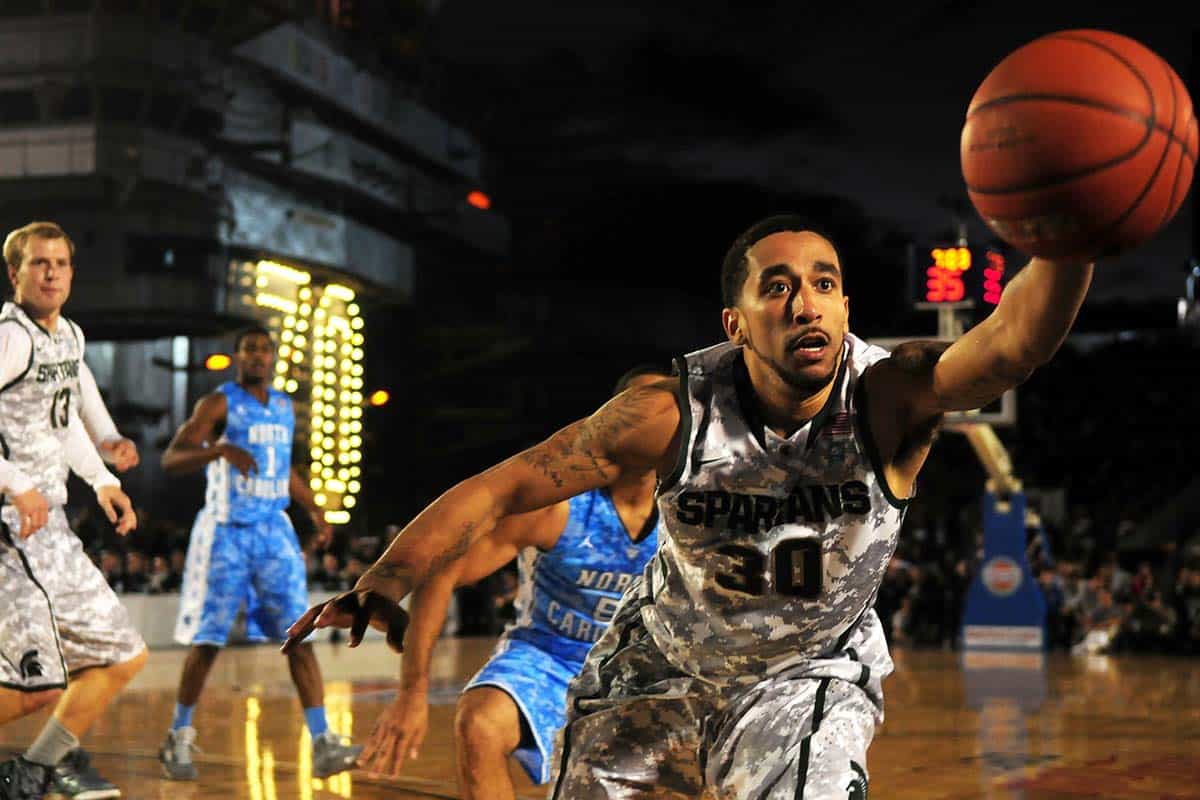Take a look at the list of most popular sports in the world and see where basketball stands. It occupies the third position, with a huge fan base of 2.2 billion people the world over. So, why won’t people go ballistic for basketball? The skills and movements players display while trying to get the ball to an opponent’s hoop, including tackles, make the game engaging to watch. Now here is one popular question people ask;
Is basketball a contact sport?
The first thing I would like to say is that contact is unavoidable in basketball. So, it is safe to say that basketball is both a contact and a non-contact sport. However, when Dr. Naismith invented the game back in 1891, it was played as a non-contact sport. What this means is that players are not supposed to have physical contact with their opponents. You can try to get the ball from the opponent and not have contact. But is that even possible? Anyway, saying basketball is a semi-contact sport means that some contacts are permitted while some aren’t and would be viewed as a foul.
Keep reading to get more details about basketball, contact, and non-contact sports.
Contact And Non-Contact Sports: Meaning And Examples
Alright, we have established the fact that basketball is a contact sport. Players can bang and bump into each other. That’s how the game is. There are even chargers in basketball that will knock you off your feet. However, you can’t push or mow someone down like you do while playing rugby. It will be counted as a foul.
That is how basketball is. Furthermore, there is a difference between contact and non-contact sports. Let’s look at their definitions for a proper understanding of both terms.
Firstly, what is a contact sport?
A contact sport is a sport where there is physical contact during the game. Meaning, both opponents can touch each other while playing, at least to some degree, without being penalized.
The setup and manner in which such games are played make it impossible for the opponents (players from both sides) not to have physical contact. By and large, you need to understand that the referee penalizes some form of physical contact in contact sports.
As earlier said, basketball is a contact sport, while sports like wrestling can be termed as a full-contact sport. You can’t group wresting and basketball in the same category, given the nature of the physical contact.
Again, in contact sports, there is player-to-object contact and player-to-player contact. An example of the former is the hockey game, where the nature of the game allows players to make contact with their hockey sticks while playing.
But in the player-to-player contact kind of sports, the players from each side tend to have contact. An example is the football game. Nevertheless, there is a certain degree or level of contact not considered as a foul in such sports.
What are the types of contact sports? Firstly, let’s split contact sports into two different categories. One will be full contact, and the other just contact sports.
Let’s take a look at the full-contact sports.
- BoxingUFC
- Wresting
- Martial arts
- Sumo
- Sanshou
- Muay Thai
- Taekwondo
- Full contact karate
- Mixed martial art (UFC)
Examples of contact sports that are not full contact:
- Water polo
- Hurling
- Slamball
- Shinty
- basketball
- Ice hockey
- Rugby league
- Wheelchair rugby
- American football
- Association football
Alright, take a read on the following explanation.
Firstly, understand that contact sports have varied terminologies. In the United States of America, for example, the terms used for contact sports are collision sports, contact, and limited-contact sports.
Now, allow me to explain how each of these contact sports differs;
Let me start with collision sports. Examples of collision sports are boxing, rodeo, American football, and ice hockey. The reason these types of games are called collision sports is how the players or athletes make their contacts.
These types of sports won’t come to an end without the players colliding with each other. The equipment being used, or they may even smash themselves to the ground. Also, they tend to collide with a large force, which may cause significant injury.
Next is the contact sport. The difference between this sport type and the collision sport is the force that stems from the collision. The players or athletes usually collide with themselves or the equipment they are using, though the force is often not as high as that experienced in collision sports. Examples of these types of sports include soccer and basketball.
Finally, we have the limited-contact sports. In terms of the force exerted during a collision, this type of sport is in a better position. So, there is less injury because there is less room for the athletes to collide with each other or with an inanimate object (equipment they are using or other fittings in the surrounding). Examples include squash and softball.
Next is the non-contact sport. Let’s take a look at the meaning of this type of sports.
Non-contact sports refer to sports where the athletes or players have no means of having physical contact. As a consequence of the no-contact, the risk of sustaining an injury is low in such sports.
Let’s take a look at some of the examples of non-contact sports for better understanding.
- Running
- Swimming
- Diving
- Rowing
- Pool
- Darts
- Cricket
- Tennis
- Golf
- Bowling
- Badminton
- bodybuilding
- Gymnastic
Is Banning Contact Sports A Wise Move?
In sports, apart from dealing with defeat, one of the things athletes suffer is injury. Also, not having physical contact, as is the case with non-contact sport, doesn’t make such sports injury-free. Athletes still pick up one or two injuries during training or while playing.
For example, in table tennis, a non-contact sport, the injuries athletes might sustain aren’t as a result of contact with another player, but they are still very severe. Some of the injuries athletes sustain are elbow injuries, muscle strain, overuse injury, calf strain, knee joint injuries, racket injuries, and many more.
Again, the funny thing about injuries that most athletes sustain in non-contact sports is that they can be very severe and put the athletes away for months. Most of the athletes may even undergo surgery to fix the injury sustained while playing or training.
So, you can see that non-contact sports are equally as risky and injury-prone as contact sports. But the thing is the rate at which injuries take place in contact sports are much higher.
Let’s consider wrestling, a high-risk and full-contact sport. Most wrestling superstars suffer several degrees of injures such as tongue cuts, bruises, scrapes, cauliflower ear, shoulder injuries, knee, and head injuries.
What about basketball? Well, in basketball, athletes still have a high risk of sustaining injuries. Below are some of the injuries that are common in basketball.
Foot and ankle injury – Ankle sprain is one of the foot injuries basketball stars suffer. It happens when one twist or awkwardly turns his or her ankle. As a consequence, the ankle’s ligaments get stretched or tears. The pain could be severe, and there could be swelling or stiffness around the area.
Thigh and hip injury – You may have heard of contusion (deep thigh bruising) before. It is another injury tied to the sport, basketball. It occurs with a player’s knee, or elbow strikes another player’s thigh muscles.
Wrist and hand injury – All the passes, catches and steals in basketball comes with a price. Players may suffer from jammed fingers. It happens when the ball hits the finger instead of landing in the player’s palm. But this injury isn’t that severe and heals quickly.
Head and face injury – Players often suffer cuts to their face or head. It happens when one collides with another. Instant treatment involves bandaging the wound. But it has to be cleaned and disinfected. However, deep cuts may require stitches.
So, is banning all contact sport a wise move? Well, the answer is subjective. For me, injuries in sports are inevitable. They are prone to occur. But then, contact sports are too risky, let’s face the fact.
Nevertheless, banning contact sports may even cause more damages. Many people who are breadwinners in their families will become jobless. Plus, we won’t get to watch our favorite games again.
So, I would say the best thing would be to apply stricter measures to discourage players from putting in rough tackles and ensure they don’t inflict injuries on their opponents. Make the players understand that sport should be treated as a competition, not a war.
Conclusion
So, is basketball a contact sport? Yes, it is. But there are tackles or contact you dare not make. A rough tackle will be counted as a foul, and players get penalized for that. However, it should be known that basketball is not much of a contact sport than wrestling or boxing. These are full-contact sports where contacts are made with greater force.
You May Like These Articles As Well:
Golf Club Reshafting Cost: Things To Know







